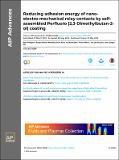Reducing adhesion energy of nano-electro-mechanical relay contacts by self-assembled Perfluoro (2,3-Dimethylbutan-2-ol) coating
Author(s)
Fathipour, Sara; Almeida, Sergio Fabian; Ye, Zhixin Alice; Saha, Bivas; Niroui, Farnaz; King Liu, Tsu-Jae; Wu, Junqiao; ... Show more Show less
DownloadPublished version (1.747Mb)
Publisher with Creative Commons License
Publisher with Creative Commons License
Creative Commons Attribution
Terms of use
Metadata
Show full item recordAbstract
© 2019 Author(s). To enable energy-efficient electronic devices for the future, nano-electro-mechanical (NEM) relays are promising due to their high ON/OFF current ratio and potential for low operating voltage. To minimize hysteresis and, consequently, relay operating voltage, it is imperative to reduce the relay contact adhesion, which can be achieved by coating the contacts with anti-stiction self-assembled monolayers. Herein we report a 71% reduction in hysteresis voltage by utilizing a branched perfluorocarbon antistiction molecule: Perfluoro (2,3-Dimethylbutan-2-ol) (PDB) on top of the tungsten contact surfaces. Experimental results show the operation of a PDB-coated NEM relay with abrupt switching, undetectably low OFF-state current, hysteresis voltage as low as 20 mV, and a large ON/OFF current ratio (>107).
Date issued
2019Department
Massachusetts Institute of Technology. Department of Electrical Engineering and Computer ScienceJournal
AIP Advances
Publisher
AIP Publishing